


C57BL/6-Nkg2dtm2(NKG2D)Bcgen/Bcgen • 112497
| Product name | B-hNKG2D mice plus |
|---|---|
| Catalog number | 112497 |
| Strain name | C57BL/6-Nkg2dtm2(NKG2D)Bcgen/Bcgen |
| Strain background | C57BL/6 |
| Aliases | NKG2D (KLR; CD314; KLRK1; NKG2-D; D12S2489E) |
Gene targeting strategy for B-hNKG2D mice plus. The 5’UTR and exons 2-8 of mouse Nkg2d gene encoding the full-length were replaced by 5’UTR and exons 2-8 of human NKG2D in B-hNKG2D mice plus.

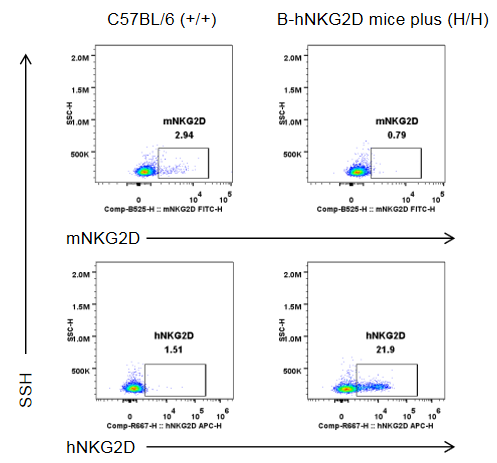
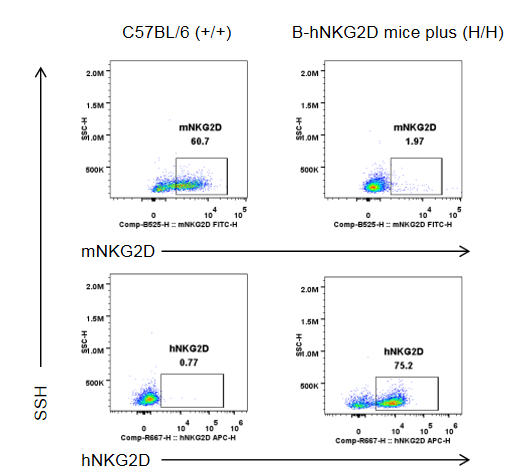

Strain specific NKG2D expression analysis in wild-type C57BL/6JNifdc mice and homozygous NKG2D humanized mice by flow cytometry. Splenocytes were collected from wild-type C57BL/6JNifdc mice (female, n=3, 6-week-old), homozygous B-hNKG2D mice (female, n=3, 6-week-old) and homozygous B-hNKG2D mice plus (female, n=5, 6-week-old), and analyzed by flow cytometry with anti-mouse NKG2D (BioLegend, 115711) and anti-human NKG2D (eBioscience, 46-5878-42) antibody. NKG2D expression was analyzed in NK cells gated by NK1.1+. Mouse NKG2D was only detectable in wild-type C57BL/6JNifc mice. Human NKG2D was exclusively detectable in NKG2D humanized mice, and NKG2D expression levels in five B-hNKG2D mice plus was consistent, and was higher than that in B-hNKG2D mice.

Strain specific NKG2D expression analysis in wild-type C57BL/6JNifdc mice and homozygous NKG2D humanized mice by flow cytometry. Splenocytes were collected from wild-type C57BL/6JNifdc mice (female, n=3, 6-week-old), homozygous B-hNKG2D mice (female, n=3, 6-week-old) and homozygous B-hNKG2D mice plus (female, n=5, 6-week-old), and analyzed by flow cytometry with anti-mouse NKG2D (BioLegend, 115711) and anti-human NKG2D (eBioscience, 46-5878-42) antibody. NKG2D expression was analyzed in CD8+ T cells gated from T cells. Mouse NKG2D was not detectable in CD8+ T cells from wild-type C57BL/6JNifc mice. Human NKG2D was exclusively detectable B-hNKG2D mice plus but not in B-hNKG2D mice.

Strain specific NKG2D expression analysis in wild-type C57BL/6JNifdc mice and homozygous NKG2D humanized mice by flow cytometry. Splenocytes were collected from wild-type C57BL/6JNifdc mice (female, n=3, 6-week-old), homozygous B-hNKG2D mice (female, n=3, 6-week-old) and homozygous B-hNKG2D mice plus (female, n=5, 6-week-old), and analyzed by flow cytometry with anti-mouse NKG2D (BioLegend, 115711) and anti-human NKG2D (eBioscience, 46-5878-42) antibody. NKG2D expression was analyzed in CD4+ T cells gated from T cells. Both mouse NKG2D and human NKG2D were not detectable in CD4+ T cells.
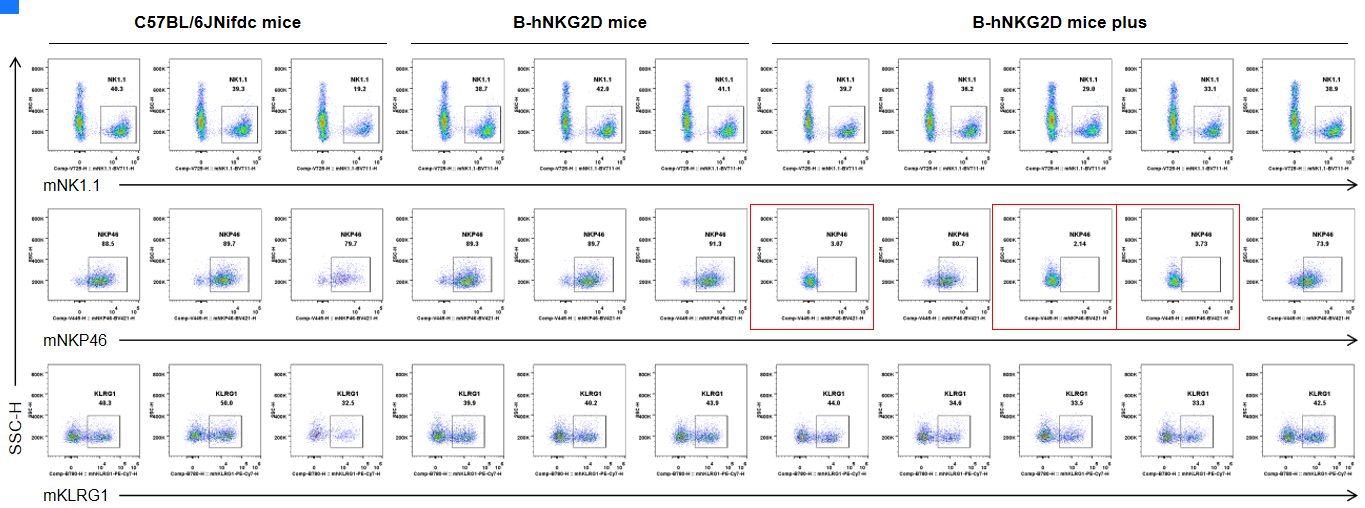
Protein expression analysis of NK1.1, NKP46 and KLRG1 in wild-type C57BL/6JNifdc mice and homozygous NKG2D humanized mice by flow cytometry. Splenocytes were collected from wild-type C57BL/6JNifdc mice (female, n=3, 6-week-old), homozygous B-hNKG2D mice (female, n=3, 6-week-old) and homozygous B-hNKG2D mice plus (female, n=5, 6-week-old), and analyzed by flow cytometry with anti-mouse NK1.1, anti-mouse NKP46 and anti-KLRG1 antibody. mNKP46 and mKLRG1 expression were analyzed from NK1.1+ cell populations. NK1.1 and KLRG1 expression was consistent between NKG2D humanized mice and wild-type mice. But mNKP46 was not detectable in three of the five B-hNKG2D mice plus.
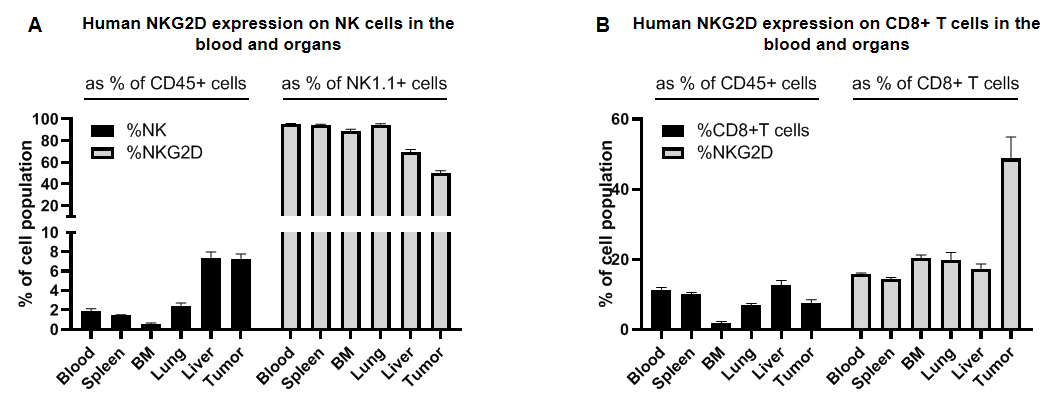
Human NKG2D is ubiquitously expressed on NK cells(A) and CD8+ T cells(B) in B-hNKG2D mice plus females bearing MC38-hTAA tumors. Blood, spleen, bone marrow(BM), lung, liver and tumor were collected from homozygous B-hNKG2D mice plus (H/H), and analyzed by flow cytometry with species-specific anti-human NKG2D antibody.
Note: This experiment was performed by the client using B-hNKG2D mice plus. All the other materials were provided by the client.
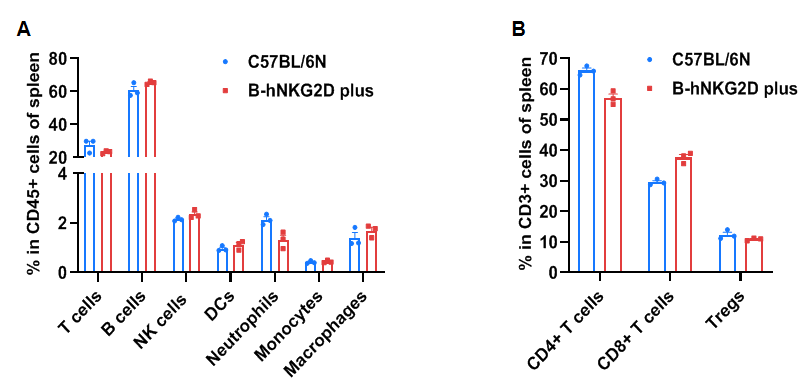
Frequency of leukocyte subpopulations in spleen by flow cytometry. Splenocytes were isolated from wild-type C57BL/6N mice (male, n=3, 7-week-old) and homozygous B-hNKG2D mice plus (male, n=3, 7-week-old). A. Flow cytometry analysis of the splenocytes was performed to assess the frequency of leukocyte subpopulations. B. Frequency of T cell subpopulations. Percentages of T cells, B cells, NK cells, dendritic cells, monocytes, macrophages, neutrophils, CD4+ T cells, CD8+ T cells and Tregs in B-hNKG2D mice plus were similar to those in C57BL/6N mice. Values are expressed as mean ± SEM. Significance was determined by two-way ANOVA test. *P < 0.05, **P < 0.01, ***p < 0.001.
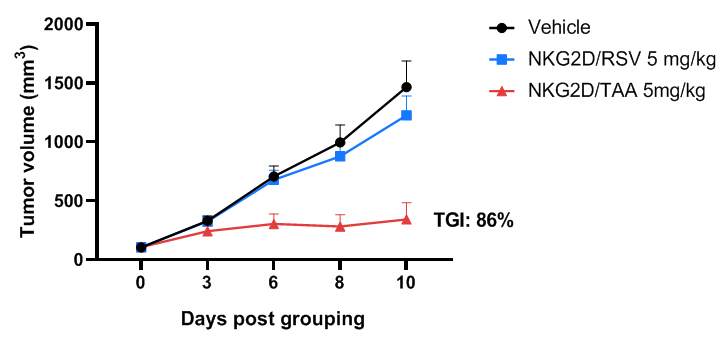
Treatment with NK cell engagers demonstrated significant anti-tumor activity against MC38-hTAA tumors B-hNKG2D mice plus. Female B-hNKG2D mice plus(n=8 in each treatment group) were inoculated with 5x105 MC38-hTAA tumor cells subcutaneously in the right flank. On day 0, 3 and 6 mice received 5 mg/kg of NKG2D/TAA intravenously (i.v). Mean tumor volume ± SEM presented. TGI: Tumor growth inhibition; TAA: tumor associated antigen; RSV: respiratory syncytial virus; SEM: standard error mean.
Note: This experiment was performed by the client using B-hNKG2D mice plus. All the other materials were provided by the client.